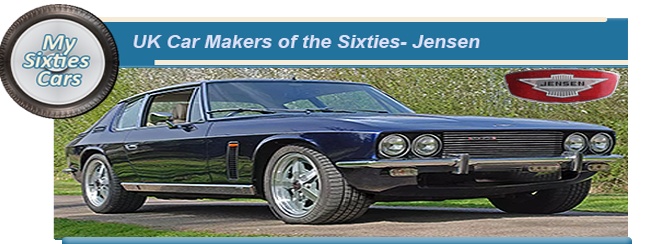
The story of Jensen Motors began in the mid-Thirties when brothers Alan and Richard Jensen got together to establish the Jensen Motor Company.
Both only in their Twenties, the Jensen brothers were already well known in the UK car industry, thanks to their love and passion for motor vehicles.
Even before they formed their company, the brothers had a strong reputation for being both talented and ambitious.
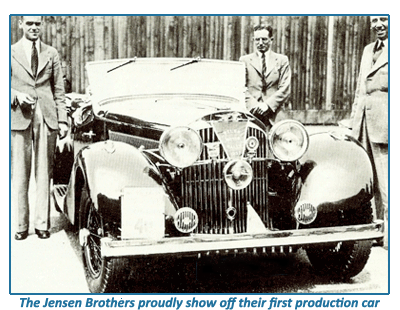 The Jensen Brothers established their company from a coach building concern by the name of W. J. Smith and Sons, based in the town of Lyng, in the Midlands of England, traditionally a hotbed for the UK motor industry.
The Jensen Brothers established their company from a coach building concern by the name of W. J. Smith and Sons, based in the town of Lyng, in the Midlands of England, traditionally a hotbed for the UK motor industry.
The owners of W.J. Smith, on the serious lookout for some talent to restore the fortunes of the company, made the genius move of offering the Jensen Brothers the role of joint Managing Directors of the company.
The Jensens were delighted at the opportunity had been looking for the opportunity to work together and grasped the offer with all four hands.
Over the next few years revived the company’s fortunes and eventually acquired full fiscal control.
From the moment that the Jensen company sign was hung over the door of their West Bromwich plant, the partnership took on a whole new stratosphere, rapidly gaining a solid reputation thanks to the consistently high standards of craftsmanship, design flair and engineering excellence.
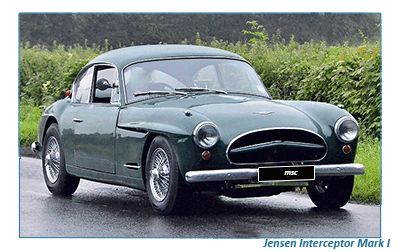 Until the outbreak of the Second World War, Jensen’s activities were based almost entirely on producing car bodies for such UK industry giants as Morris, Singer, Standard and Wolseley, as well as some companies involved in the commercial vehicle sector.
Until the outbreak of the Second World War, Jensen’s activities were based almost entirely on producing car bodies for such UK industry giants as Morris, Singer, Standard and Wolseley, as well as some companies involved in the commercial vehicle sector.
Despite the difficulties, Richard and Alan Jensen succeeded in keeping the company afloat throughout the Second World War, playing their part in helping the war effort.
From 1946 onwards the Jensen brothers decided that the time was right to diversify and expand their activities, taking their first tentative steps into production.
During the Fifties, Jensen Motors developed just three models, the first two, the PW and Interceptor meeting with little commercial success or interest. On the other hand, the Jensen 541 model, with the glass-fibre body, created tremendous interest and so well, becoming generally regarded as one of the most exciting sports saloons of the decade.
![]()
As well as getting the car manufacturing division underway, Jensen also continued to produce bodies for the U.K.'s leading car companies, among them the iconic Austin A40 Sports, Austin-Healey 100/3000 and Sunbeam Tiger.
Many of the lessons that the Jensens learned in the Fifties in the field of car production were carried on successfully into the next decade.
A decade where they enhanced their reputation as top-class manufacturers of specialist cars.
Jensen stepped into the Sixties with the launch of the 541S, an almost totally updated version of the 541R, broader and longer than its predecessor, and powered by a three-carburettor, 4-litre BMC engine matched up to the Rolls-Royce version of GM Hydra-Matic automatic transmission.
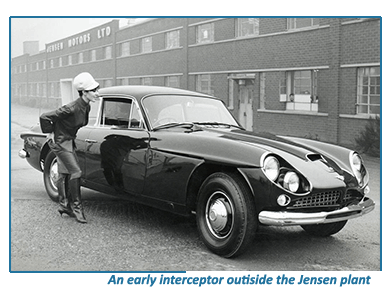 As before, the body was made up of glass-fibre, apart from the aluminium-panelled doors. with a host of refinements, -- while luggage space was also improved.
As before, the body was made up of glass-fibre, apart from the aluminium-panelled doors. with a host of refinements, -- while luggage space was also improved.
Seat belts were also standardised (and many other items usually available only as extras were standard in the Jensen), making this the first British car so equipped.
Despite the usual high hopes, sales for the 541S did not really take off, with just over one hundred sold in the two years that the car was in production.
Even before the plug was pulled on the 541S, its replacement, the C-V8 was already in production, launched in October 1962.
The allure of the large-capacity American V8 engine with it's easy, smooth torque and power output, had attracted Jensen just as it had attracted Bristol, and they chose a 5916-cc Chrysler V8 producing 305 bhp gross and dropped it into a body very similar to the basic type 541 shell.
Still produced in glass-fibre, still beautifully finished and lavishly equipped, the C-V8 used another version of the massive tubular and boxed pressing, mating the Chrysler engine to a Torqueflite transmission from the same manufacturer.
Among the standard equipment found on the C-V8 were reclining front seats, a Motorola radio with twin speakers and a roof-concealed aerial, laminated glass throughout, safety belts, a fascia-controlled filler cap and even a fire extinguisher.
Despite it a wealth of features, the Jensen C-V8 Mark I offered good value regarding performance, individuality, luxury, and fittings.Top speed was a true 136 mph, 0-50 time under 6 sec, and fuel consumption about 16 mpg.
![]()
All in all, Jensen released three versions of the C-V8, with the Mark II given more power and the Mark III a significant facelift.
By the mid-Sixties, it appeared to be business as usual at Jensen with one or two models on offer, and an average production of 1.5 cars weekly.
It was around that time that the Jensen Brothers decided to shake things up a little with the launch of a new model that would push their company up a whole new level, both in terms of critical appeal and commercial success.
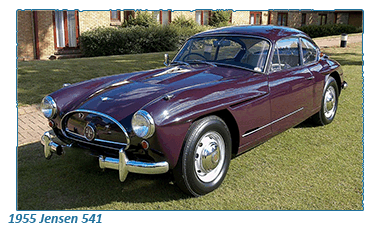 The first and ultimately decisive step was the brother’s decision to the Italian coachbuilder, Carrozzeria Touring was commissioned to design and construct a batch of pre-production cars.
The first and ultimately decisive step was the brother’s decision to the Italian coachbuilder, Carrozzeria Touring was commissioned to design and construct a batch of pre-production cars.
With the Interceptor, Carrozzeria Touring succeeded in meeting Jensen’s stipulation to design a car that combined the best of Italian GT design characteristics and solid UK engineering and finish.
Late in 1965, when the Interceptor was at an advanced design stage, Jensen Motors was approached by a company known as FF short for 'Ferguson Formula,' an offshoot of the massive Massey Ferguson tractor manufacturers.
FF had been involved for some years in developing a four-wheel-drive platform that could be used on a road car and decided that the soon to be launched Interceptor would be an ideal pairing for their development.
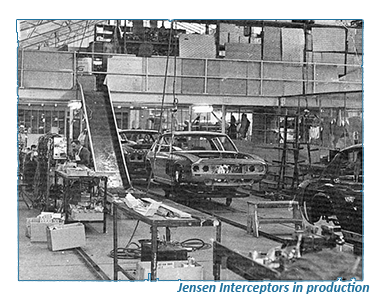 The Jensens were enthusiastic about being involved in the project, the Jensen FF, with the first car going on show alongside the Interceptor at the Earl's Court Motor Show in 1966.
The Jensens were enthusiastic about being involved in the project, the Jensen FF, with the first car going on show alongside the Interceptor at the Earl's Court Motor Show in 1966.
The Jensen FF was identical to Interceptor, powered by the same the 330-bhp 6.2-litre Chrysler engine with its Torqueflite transmission offset but four inches longer.
In general, the motoring media were impressed by the FF concept but rightly feared that it could be viable commercially due to the car’s price tag, which was disproportionately high, with each vehicle needing to be virtually hand produced.
On the other hand, the Sixties motoring press was ecstatic about the Interceptor, and the car did indeed go on to be a tremendous success, remaining in production for more than a decade, and pushing up production almost tenfold.
Despite suffering some financial hiccups during the Seventies which saw the company being placed in the receiver's hands, Jensen rose again for a a period duriung the "noughties" before finally closing in 2011. The company will always be held in high regard in the annals of auto history, thanks to their ability to produce extraordinarily sophisticated machines. years ahead of their time.






